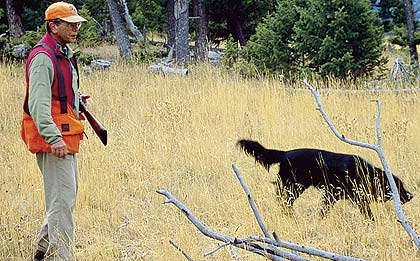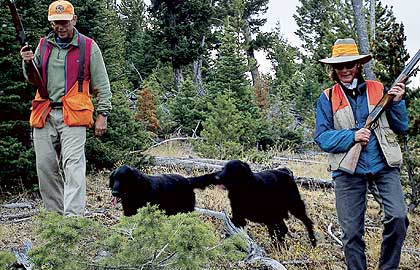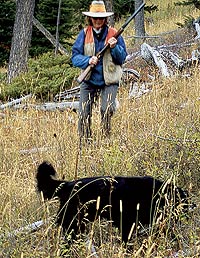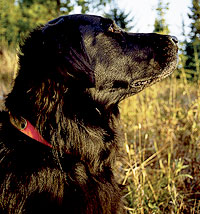Flat-Coated Retrievers May Have A Strong Background As Show Dogs, But As The Author Found Out, They Can Hunt, Too.
By Dave Carty
A capsule description of flat-coated retrievers might read like this: Flat-coats: You haven't seen one.
Most people, upon seeing a flat-coat for the first time, assume the dog is some kind of golden retriever-black Lab cross. In fact, they're nothing so mundane. Legend has it that in England they were the dogs of choice for gamekeepers, but despite their sporting roots, it's been in the show rings both here and abroad that the breed is best known.
Even so, flat-coats are scarcely a blip on the radar that measures the popularity of breeds like Labs and goldens, which, to hear most flat-coat owners tell it, is just fine with them. They're more than happy to sidestep the headaches that go with breeding popular, beautiful dogs.
As a child, I had a canine encyclopedia with color plates of every known breed in the U.S, and I still recall the faded paintings of flat-coated retrievers and their regal beauty. But it wasn't until 40 years later that I actually got to meet one, courtesy of Bill and Katie Kluchko of Bozeman, Montana. Bill, a shooting buddy at our local clays club (and a pretty fair hand with a side-by-side), let it slip he'd been hunting over flat-coats for 20 years.
"You mean those dogs that look like black goldens?" I asked.
He nodded, and before he knew what hit him, I'd signed him up for a hunt. A few weeks later, I rendezvoused with Bill and his wife, Katie, in the local Wal-Mart parking lot. After tossing my vest and camera gear into the back of their van, we headed off for the mountains in search of blue grouse.
Huntin' Grouse With Fanny and Doc
That was a very good year for Montana's mountain grouse. But high populations of birds don't necessarily mean easy hunting. The main hurdle is the sheer difficulty of getting to where blue grouse live. Other hunters have told me they find them in the foothills, plucking forbs in the sagebrush. That gives me reason to hope that I may actually find them there myself someday, but so far, virtually every blue grouse I've flushed has been on the top of a ridge, and the higher the better. Logging roads only get you so far. The rest of the elevation you gain the hard way, by climbing.
 Flat ground: a relative rarity when hunting blue grouse. |
Bill and Katie were up to the task, however. They both work out regularly and it shows. Bill looks 10 years younger than his 60 years, and Katie also looks far younger than however old she is, which, for the record, I was smart enough not to ask. On the ride up, they introduced me to Fanny and Doc, the two flat-coats with whom I was sharing the back of the van.
It's easy to see how the dogs could be confused with a black Lab-golden retriever crosss. (I should also mention that flat-coats can be liver, in which case some people might wonder if they were looking at a golden retriever-chocolate Lab cross.) They're the same size and build, although they have slimmer, less square heads. But the feathering on their legs and tails and their luxurious, shiny coats are quite similar.
Unlike most of the bird dogs I've shared cars with (including mine), the two seemed content to relax and enjoy the ride. A few minutes later we pulled up to the trailhead, and while the three of us slipped on our vests, Fanny and Doc stayed close to the car, nosing around the grass.
As it turned out, the trail gave us a reprieve for a few hundred yards before it began climbing, and I had time to watch the dogs work. It was clear neither was going to kill itself hunting unproductive cover. Katie remarked that both dogs were probably worn out from hunting the day before, and whether the two were tired or simply saving their energy I had no way of knowing, but both stayed close, trotting out ahead with an occasional glance back at the three of us.
 The author's hosts, Bill and Katie Kluchko of Bozeman, Montana, and their flat-coats, Fanny and Doc. |
Although I've hunted over retrievers before and at one time owned a crackerjack springer spaniel, for most of the last 15 years I've been hunting over wide-ranging setters and moderately-ranging Brittanys, and I found myself wanting to shoo Fanny and Doc further into the woods where I thought the grouse were. To be fair, though, these were retrievers, not pointers, and their range was close but within acceptable retrieving-dog standards. I was also beginning to get an inkling of something that Bill would explain to me a few days later: Flat-coats are easily bored.
In my research on the breed, I'd run across similar statements written by other flat-coat owners. "I usually throw dummies for them," Bill told me, outlining the light training he gives his dogs. "But not a lot of them. That's one thing about the breed--they do not take repetition. It's almost like they're saying, 'I did it once; why do I have to do it again?'"
Funny how bird scent changes everything.
Getting Birdy
A half hour after we'd started, the three of us began climbing a nearly vertical, pine-studded mountainside. I pulled myself up tree limb by tree limb and finally gained the respite of a long-abandoned and blessedly flat logging road. Bill and Katie shifted their guns to the crooks of their arms and took a breather while I wheezed in the murderously thin air. Suddenly, Katie spun around and pointed at Fanny.
"Look," she said. "She's got something!"
Fanny had come alive. She charged up the mountain, her nose to the ground, plowing through the underbrush and squirming under deadfalls. A moment later, Doc joined her, and the two of them dashed around the hillside above us, Bill and Katie waiting below with their shotguns halfway to their shoulders.
But as so often happens in the grouse woods, nothing came of it. Had a brood been through there? Since Fanny and Doc are six and eight, respectively, and Bill and Katie hunt them three days a week for doves, Huns and pheasants throughout most of the generous Montana bird season, I'm fairly certain one had. Experienced dogs, no matter the breed, rarely get
worked up over chipmunks and tweety birds. A few minutes later the dogs were back at our sides, and we resumed our climb.
Twenty-plus years ago, while recovering from back surgery, Bill started shopping around for a bird dog. At the time, he was a music teacher in Aspen, Colorado. Katie worked for Obermeyer, a huge ski-clothing manufacturer of the day. Bill was just getting his feet wet as a bird hunter but already knew enough to realize he needed canine help.
"I chose them [flat-coats] because they were so easy to work with," he told me. "I went to the library and got this booklet on dog breeds, and it had this little check list. It said that flat-coats were intelligent, easy to work with, very birdy, family oriented and not aggressive (but would give warning barks). And I said, 'Gosh, this is the exact recipe for what I want.' And it's all been true."
That was four flat-coats ago. His first dog lived to be 12, the second died at age seven, and the last two were here before us, clambering up the hill in search of scent.
Presently we found an open meadow that straddled a ridgeline, nearly perfect cover. We stopped for a moment while Katie watered the dogs, admiring the view that fell away on all sides of us.
I gazed across the meadow. "There have got to be birds here," I said. All around were scattered clumps of fir and spruce, among them large, old-growth trees ringed with ground-hugging junipers. Snowberries and grass grew thickly in the sunny openings, and a type of silvery forb--a plant I hadn't yet identified but had seen in virtually every crop of every bird I'd taken that year--grew in patches underfoot. It was grouse heaven.
 Katie readies herself for a flush by one of her flat-coats. |
When the dogs had rested and the three of us had regained something like a normal heart rate, Bill struck off uphill with Fanny and Katie and I took Doc to work the edge of the clearing below. Minutes later we heard Bill fire, then fire again.
"Aw, damn!" he said.
We made an abrupt about face and headed in his direction, just in time to spy a blue as it came sailing back across the meadow above us, out of range. Doc watched it with interest. I marked it down in trees 75 yards to our right, and Katie and I hustled over to investigate.
Up here in God's country, flushing limb chickens is an accepted part of bird-hunting protocol, but it's tough to reflush a bird if you haven't seen it land. I'd seen the grouse disappear in a thick copse of spruce trees, but whether it had stopped there or had continued flying I had no way of knowing.
Walking through a dense, gloomy thicket waiting for tree flushers is as close to jungle warfare as I ever hope to get. Blues flush with a slow, throaty roar, sometimes close enough to fan the back of your head with their wing tips, although more often than not they rocket down and away from the very tip of a 75-foot Douglas fir. By the time you spot them, they'll have already reached terminal velocity while simultaneously careening through a canopy of fir and spruce limbs. It's crisp sport.
| READ UP ON FLAT-COATS |
|---|
| For a breed as obscure as the flat-coated retriever, the dogs have plenty of tech support. Here's a partial list of Web sites, phone numbers, books and organizations: |
|---|
Flat Coated Retriever Society of America (FCRSA) newsletter.
Mary Beth Bissig
mbbissig@interl.net
128 Glendale Dr.
Burlington, IA 52601-1502
(319) 754-4169 |
Breed Club
(For information booklets and brochures): |
Flat Coated Retriever Society of America, Inc.
Membership Secretary, Miriam Krum
16705 W. 32nd St.
Paola, KS 66071
(913) 849-3218 |
Ways and Means, Ann Yuhasz
5601 Liberty Rd.
Chagrin Falls, OH 44022 |
| Books |
|---|
A Review Of The Flat-Coated Retriever
Laughton, Nancy
Pelham Books Ltd.
44 Bedford Square, London
WC1B 3DU, United Kingdom
ISBN 0 7207 1228 9 |
The Complete Flat-Coated Retriever
Petch, Paddy
Boydell Press, P.O. Box 9,
Woodbridge, Suffolk IP123DF and
27 South Main St., Wolfeboro, NH
03894-2069
ISBN 0 85115 463 8 |
1994 Flat-Coated Retriever Directory of North American Dogs, Fourth Edition
Mark Cavallo
7230 Peachtree Dunwoody Road.
Atlanta, GA 30328
$38 plus S&H |
When Katie and I reached the trees, Doc plunged into the middle of them and disappeared. Then I saw Katie stop, peer around a limb and throw her gun to her shoulder. An instant later I heard the unmistakable deep thump of a flush. Katie stomped her foot in frustration. She'd seen the bird and had a wide-open shot, but had slid her thumb over the top of the safety rather than into it. Wish I could say that has never happened to me.
Turns out Bill hadn't fared much better. "It was classic Keystone Cops," he told us as we regrouped in the meadow. "I was just stepping over a log when Fanny flushed a pair. But my foot slipped on the log and I couldn't get my gun up right." He shook his head, laughing at himself. "God, that was probably my only chance for a double all season," he moaned dramatically.
 The typical flat-coat is friendly, good-looking and eager to hunt€¦but don't expect them to embrace too many repetitive training drills. |
The way I saw it, though, was that Fanny and Doc had given the birds a run for their money.
Some of the literature about flat-coats describes them as garbage eaters, mud rollers and prone to die at a young age from cancer. But Bill doesn't buy the bad press.
"As far as eating garbage? They do that," he told me. "But so do a lot of other dogs. But once we're hunting, they nev
er mess with it. They're basically laid-back dogs, but when they know we're hunting, all that nonsense stops. And they only seem to roll in mud during their first year or year and a half, when they're still teenagers."
Cancer is a more serious consideration, however. But Bill says that his own findings indicate that the high reported incidence of cancer in flat-coats, one of the more closely monitored breeds in the country, is probably due to cases simply being reported more often than with other breeds. Of his four dogs, only one has died of cancer, and his first lived to 12, a respectable age for any pooch.
Bill does suggest one thing, though: Flat-coats, he says, need plenty of attention and exercise. "Fanny, if she's around the house for five or six days, she'll start walking around carrying my sock," he says. "It's like she's saying, take me out! Take me out!"






